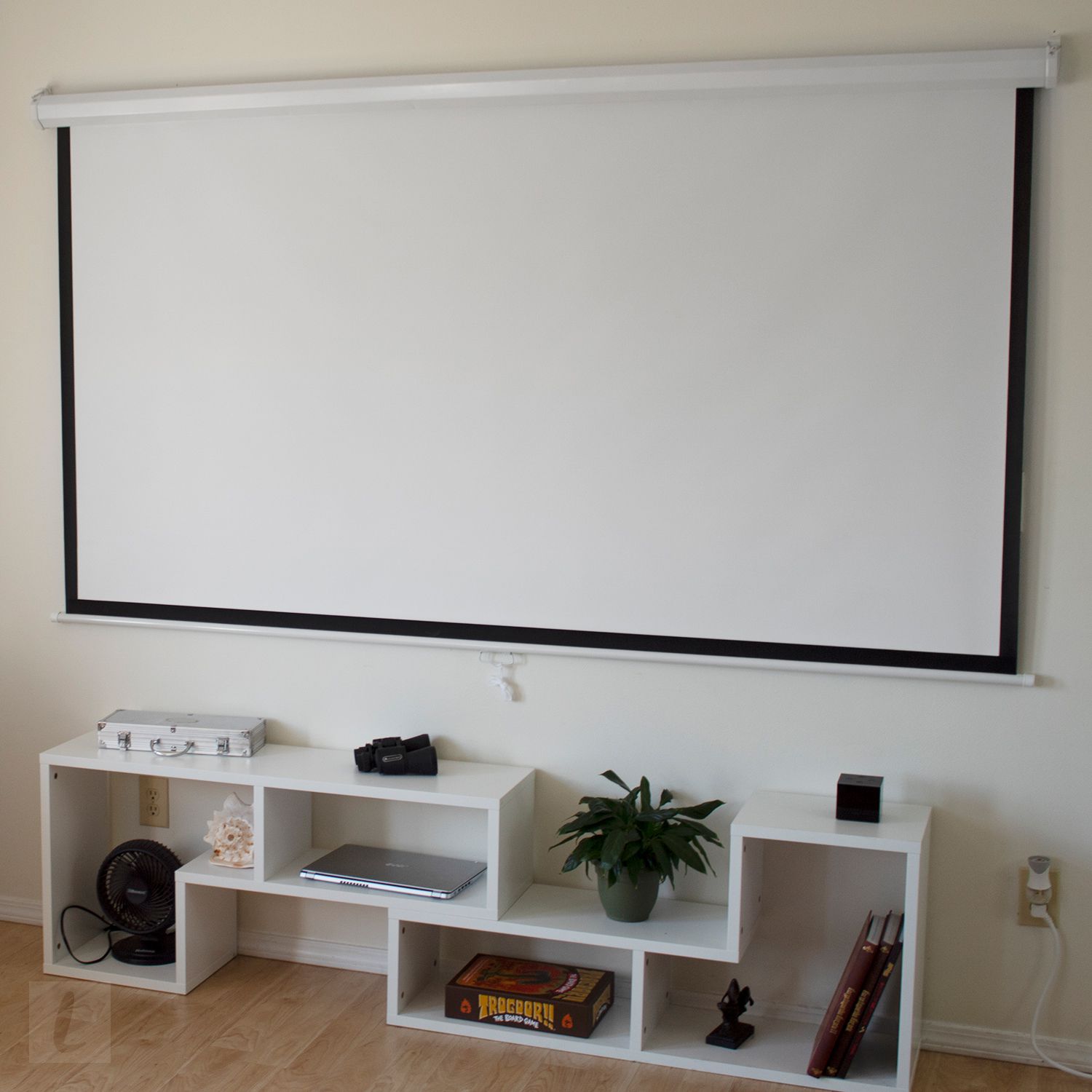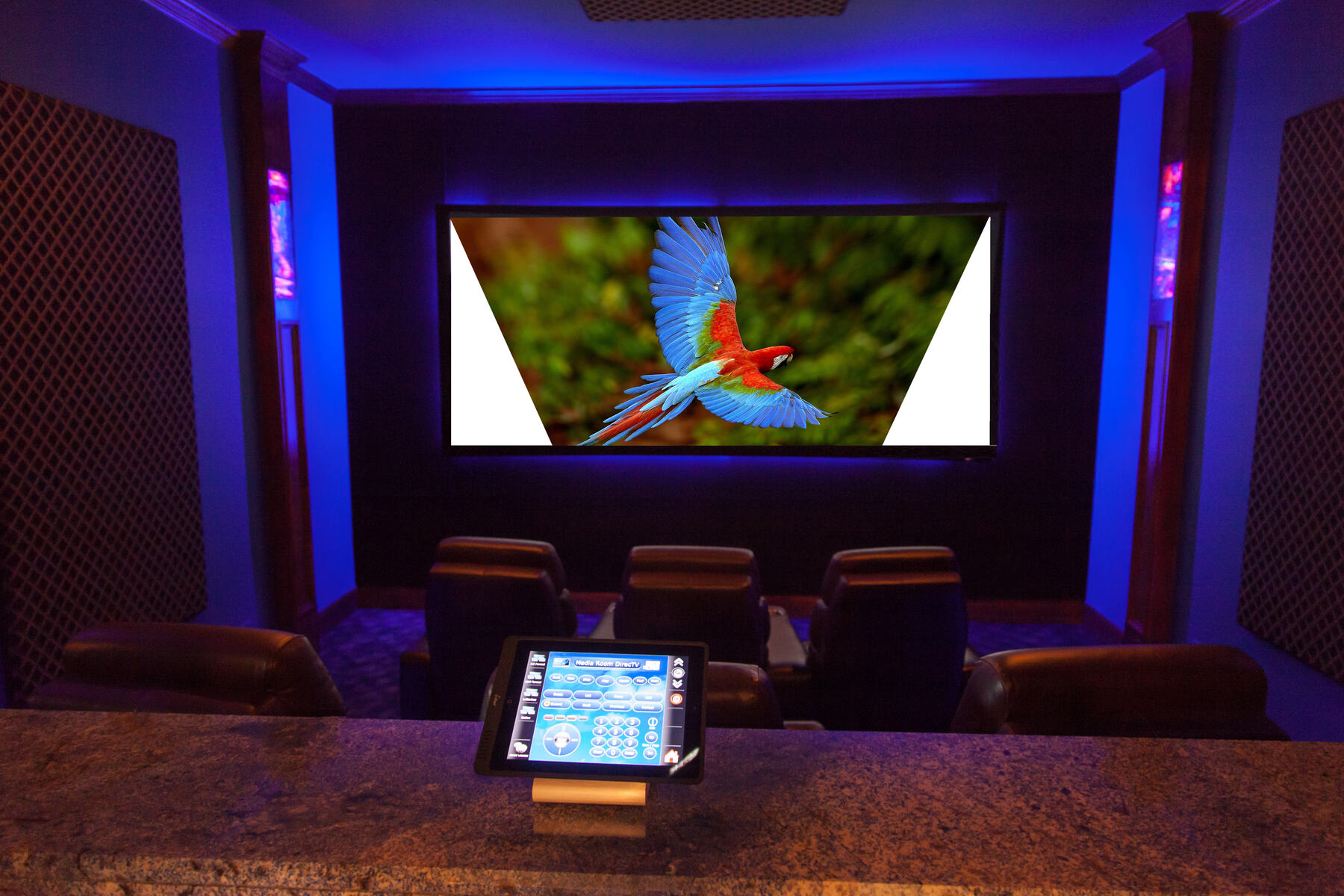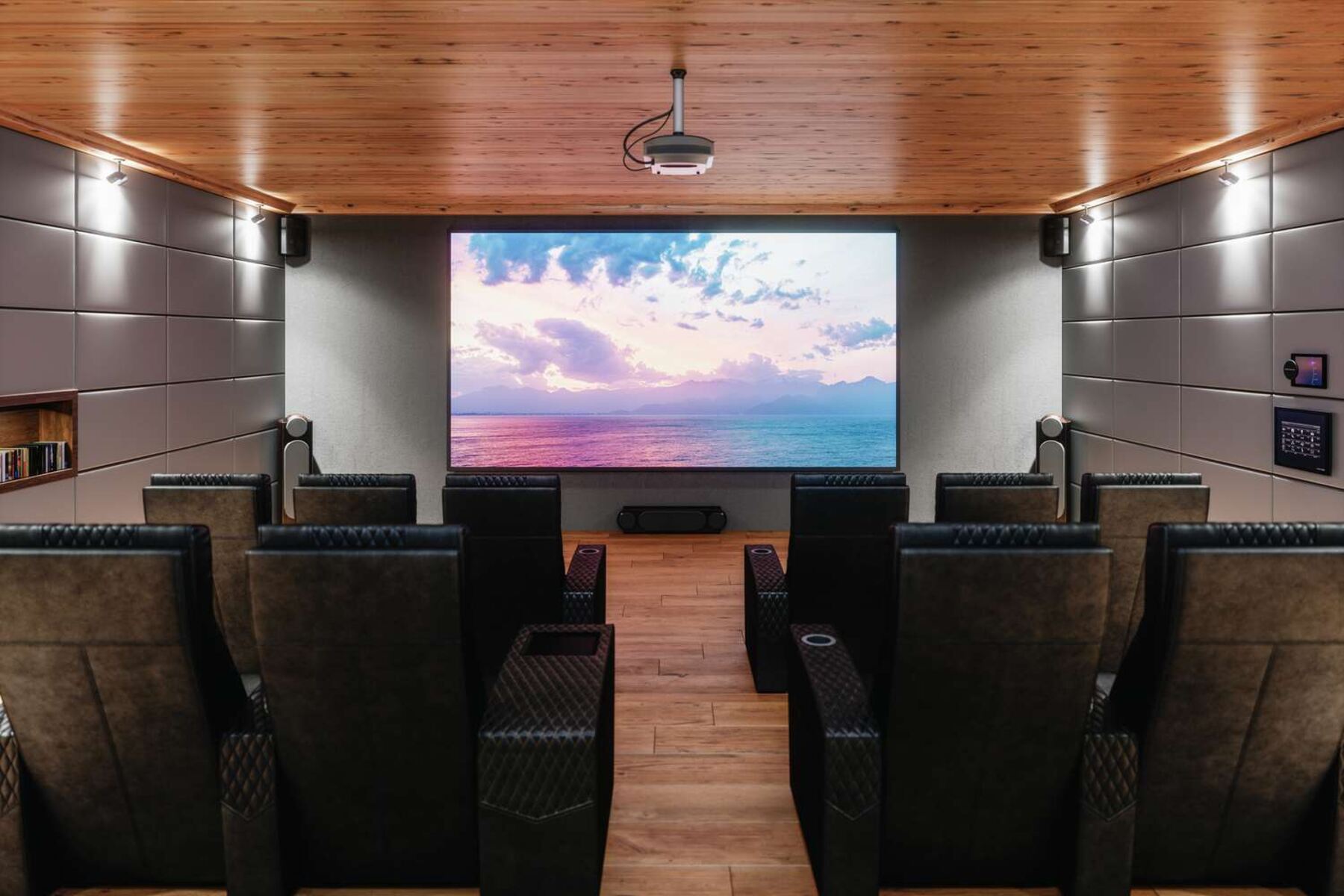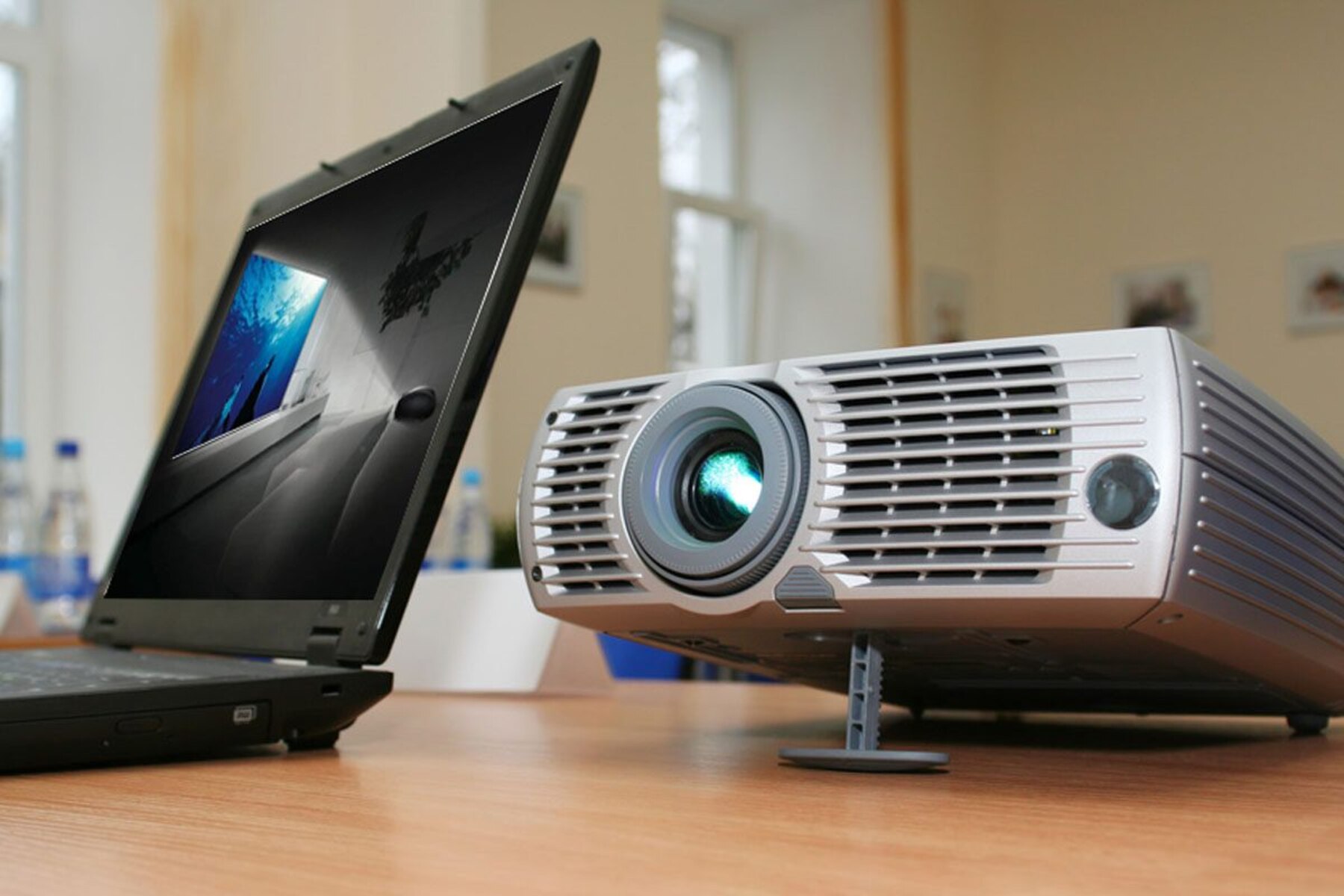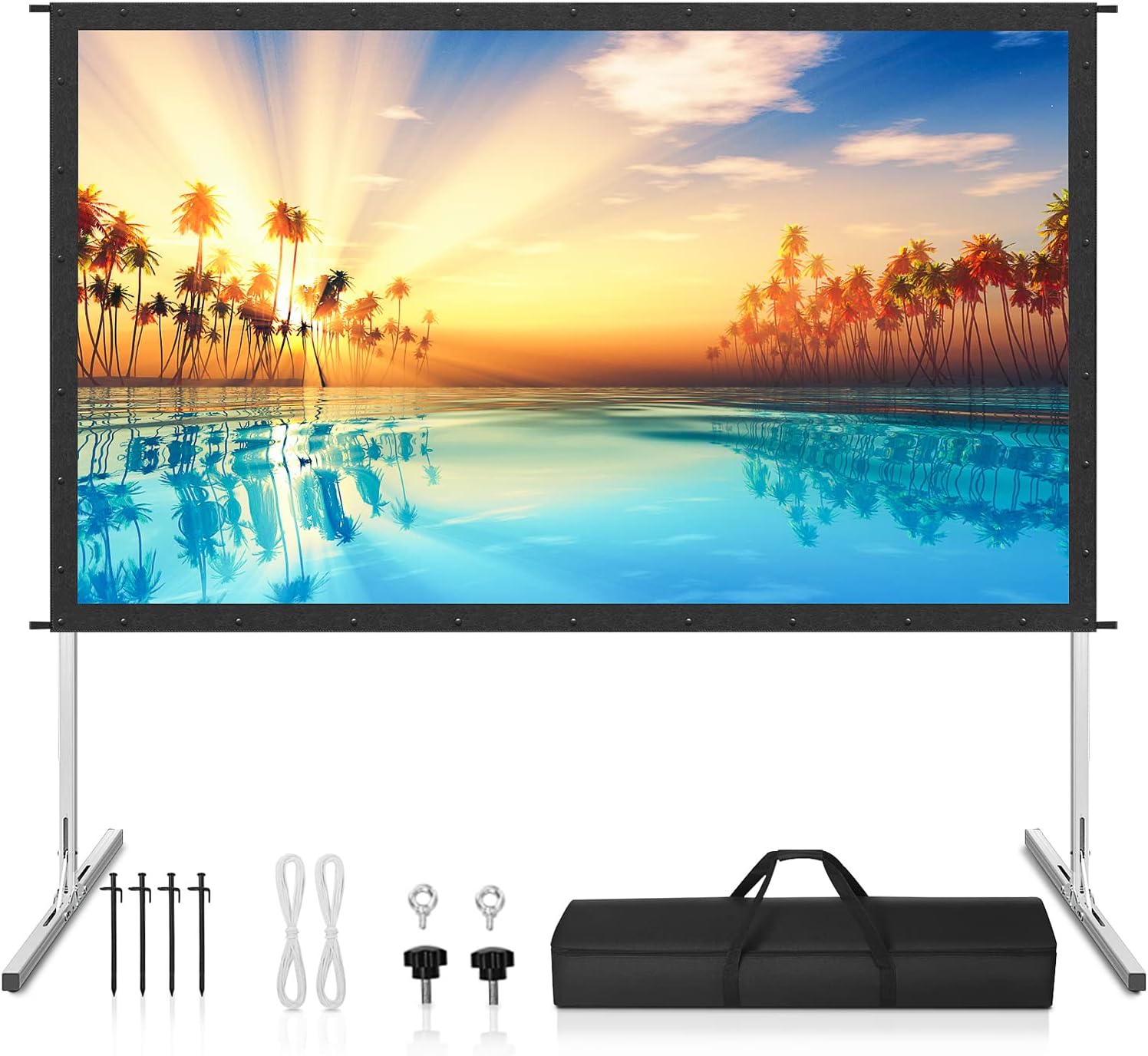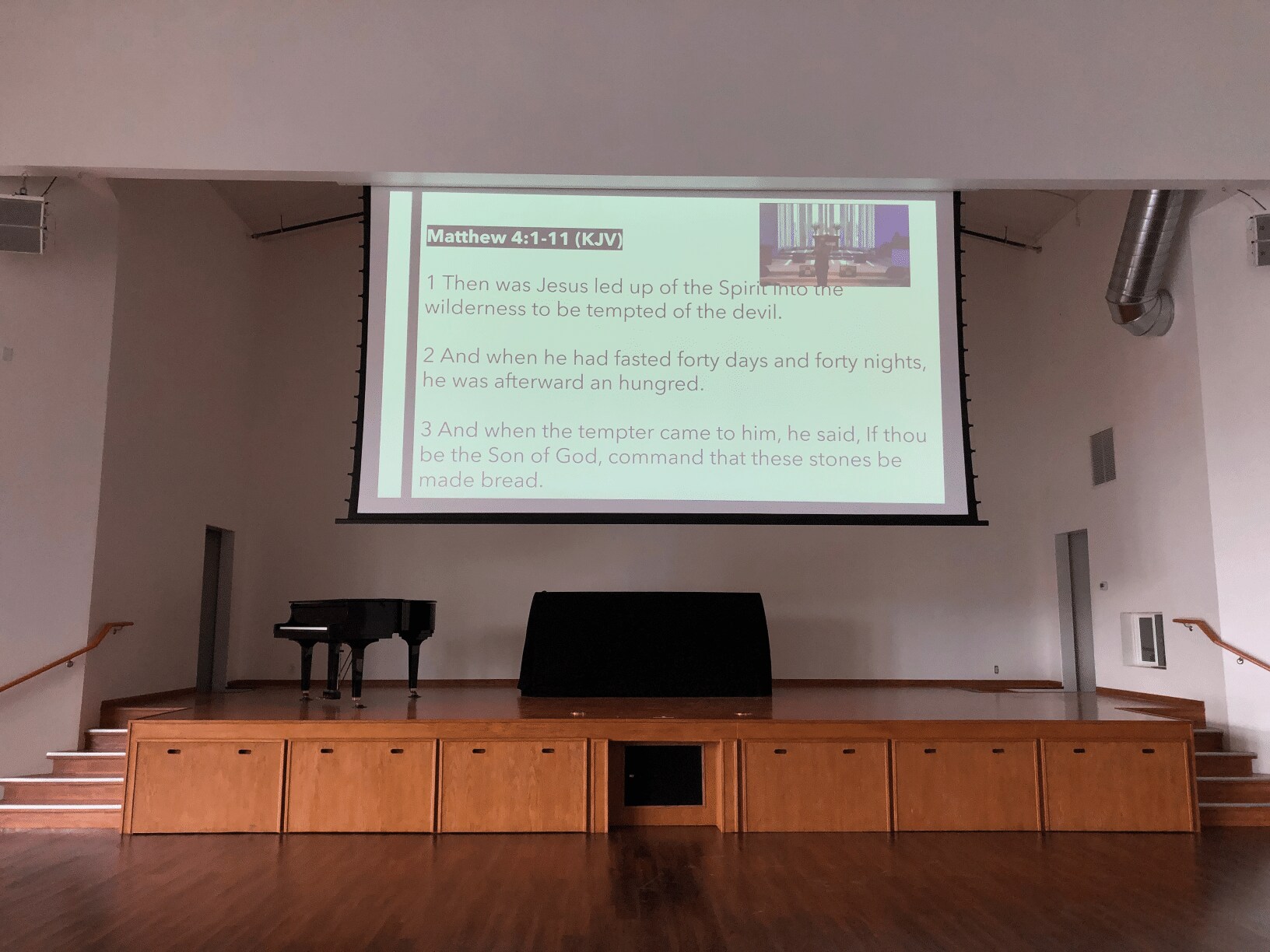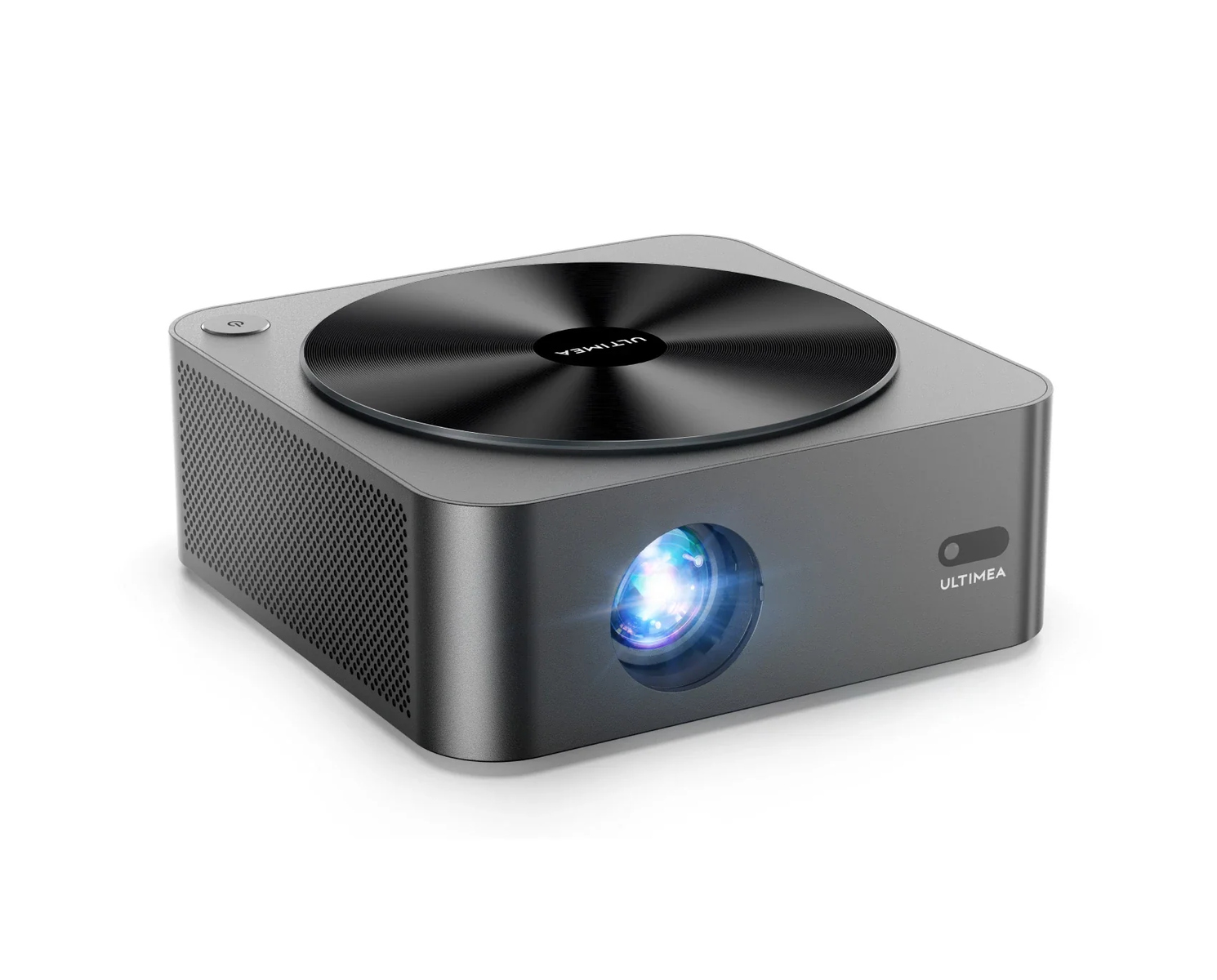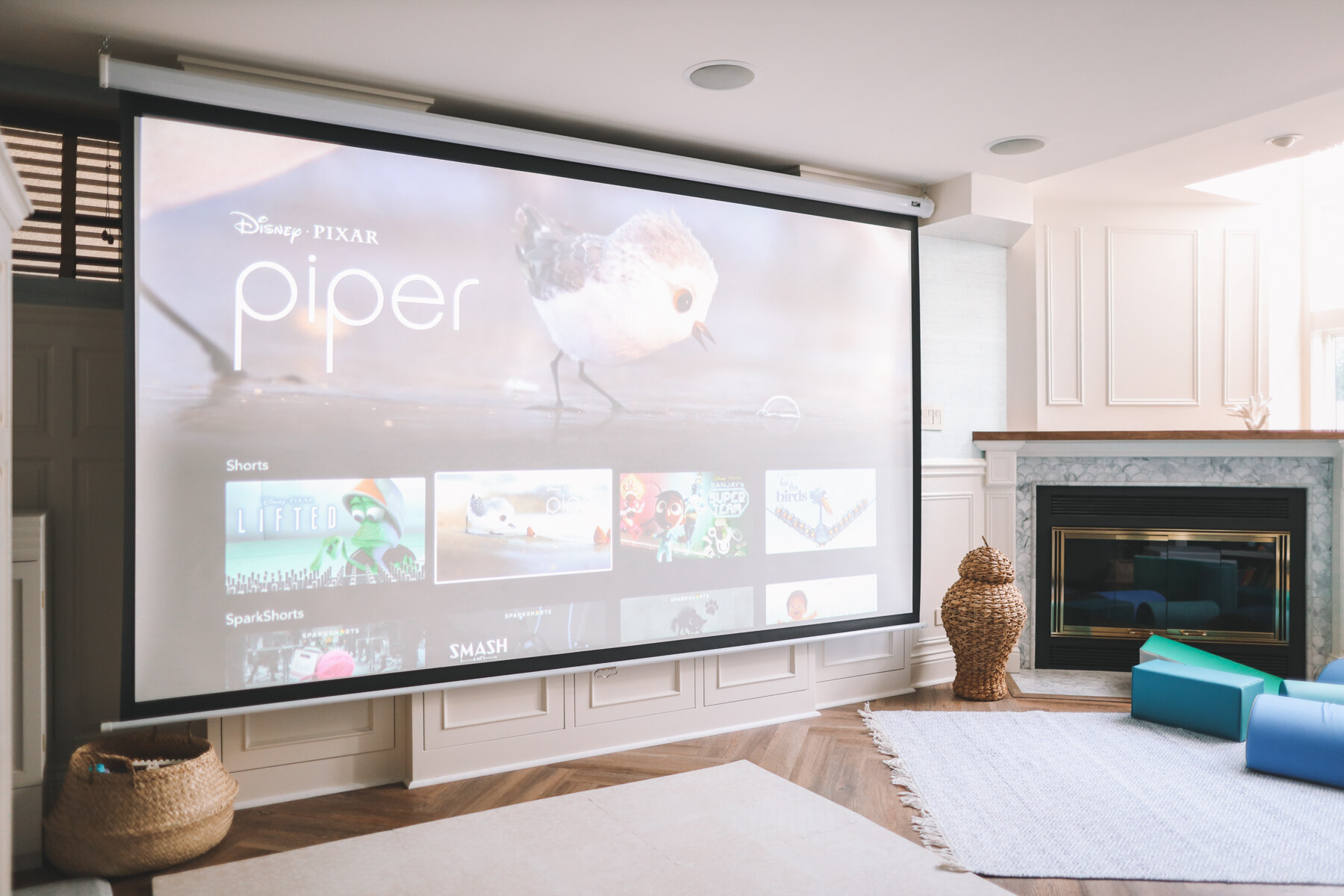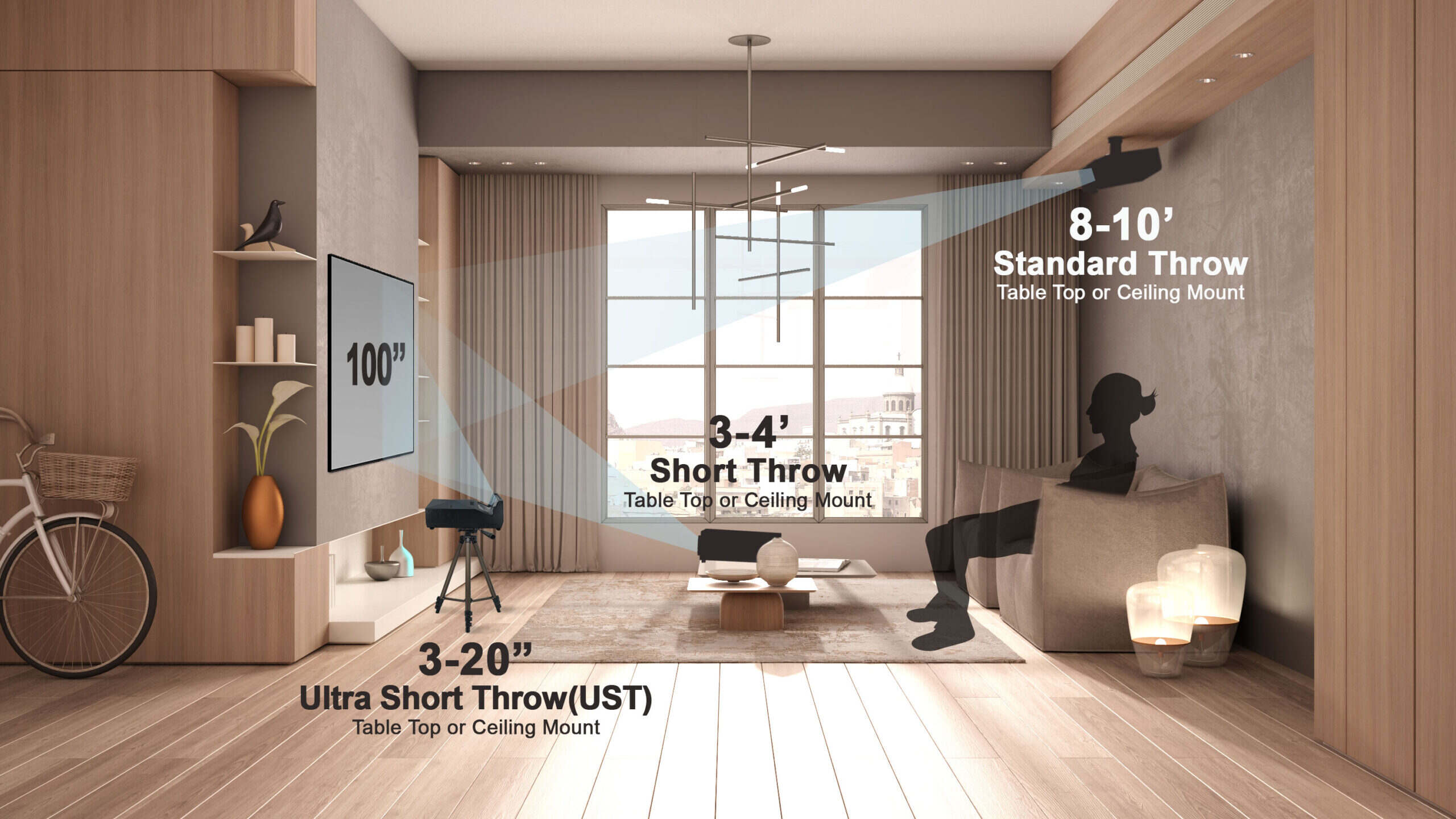Introduction
When it comes to creating a top-notch viewing experience with your projector, selecting the right projector screen is key. A high-quality projector screen can greatly enhance the image quality, color accuracy, and overall visual impact of your presentations, movies, or gaming sessions.
However, with so many options available on the market, choosing the best projector screen can be a daunting task. Factors such as screen type, size, material, and special features should all be taken into consideration. In this article, we will guide you through the process of selecting the perfect projector screen for your specific needs.
Before diving into the specific types of projector screens, it’s important to understand the factors you should consider when making a decision. Firstly, think about the intended use of the projector screen. Are you looking to set up a home theater, equip your office presentation room, or create an outdoor entertainment space? Each scenario will have its own requirements.
Next, consider the ambient light conditions of the room where the projector screen will be used. If you have a dedicated space with controlled lighting, a standard screen may suffice. However, if you have a room with windows or high ambient light, you may want to consider an ambient light rejecting (ALR) screen that mitigates the impact of external light sources.
Lastly, think about the size and aspect ratio of the screen. Consider the dimensions of the room and the viewing distance to ensure the screen size is suitable for everyone to enjoy the content without straining their eyes.
Now that we have touched on the factors to consider, let’s explore the different types of projector screens available in the market and their unique features to help you make an informed decision that meets your requirements and budget.
Factors to Consider When Choosing a Projector Screen
Before investing in a projector screen, it’s crucial to consider several factors to ensure you choose the perfect one for your needs. Here are some important considerations:
- Screen Size: Determining the appropriate screen size is essential for a satisfying viewing experience. Consider the dimensions of the room and the distance between the screen and the audience. A screen that is too large or small can negatively impact the image quality and viewer engagement.
- Aspect Ratio: Projector screens come in various aspect ratios, such as 16:9, 4:3, and 2.35:1. The aspect ratio should match the content you plan to project. For example, 16:9 is ideal for widescreen movies, while 4:3 is suitable for presentations.
- Screen Material: The material of the screen affects image quality, brightness, and viewing angle. Some materials reflect more light, resulting in a brighter image, while others enhance contrast and reduce reflection. Choose a material that suits your specific requirements.
- Gain: Gain refers to how much light is reflected back to the audience. High-gain screens provide a brighter image, while low-gain screens have wider viewing angles. Consider the room’s lighting conditions and the desired level of brightness when selecting the gain.
- Installation: Different screens require different installation methods. Some are wall-mounted or ceiling-mounted, while others are portable. Consider the available space and how you plan to set up the screen.
- Special Features: Some projector screens come with additional features, such as motorized operation, tab-tensioning to keep the screen flat, or ambient light rejection technology. Evaluate these extra features to determine if they are necessary for your setup.
- Budget: Set a budget for your projector screen purchase. Prices can vary significantly depending on the type of screen, size, and special features. Ensure that the chosen projector screen aligns with your budget and offers good value for the price.
Considering these factors will help you narrow down your options, ensuring that you choose a projector screen that delivers optimal performance and meets your specific needs. By understanding your requirements and assessing the available options, you can make an informed decision and enhance your viewing experience to the fullest.
Types of Projector Screens
Projector screens come in a variety of types, each offering unique features and benefits. Understanding the different types can help you choose the most suitable option for your specific needs. Here are some of the most common types of projector screens:
- Electric Projector Screens: Electric projector screens are motorized screens that can be controlled with a remote or wall-mounted switch. They provide convenience and seamless operation, allowing you to easily raise or lower the screen when needed.
- Fixed Frame Projector Screens: Fixed frame projector screens consist of a solid frame that holds the screen taut at all times. They provide a flat and wrinkle-free surface for superior image quality. These screens are typically used in dedicated home theater rooms or professional installations.
- Manual Pull-Down Projector Screens: Manual pull-down screens are operated manually by pulling the screen down for use and retracting it back into a casing when not in use. They are easy to install and offer an affordable option for various applications.
- Portable Projector Screens: Portable projector screens are lightweight and designed for mobility. They are easy to set up and take down, making them ideal for presentations, outdoor movie nights, and other temporary setups.
- Motorized Projector Screens: Similar to electric screens, motorized projector screens offer the convenience of remote-controlled operation. They are suitable for applications where raising and lowering the screen frequently is required.
- Tab-Tensioned Projector Screens: Tab-tensioned screens feature a tensioning system that keeps the screen surface flat, ensuring optimal image quality. They are ideal for installations where a perfectly flat screen is necessary.
- Ambient Light Rejecting (ALR) Projector Screens: ALR screens are designed to reject ambient light, providing exceptional image contrast and clarity even in rooms with high levels of external light. They are ideal for spaces with windows or bright lighting conditions.
- Rear Projection Projector Screens: Rear projection screens are designed to be viewed from the opposite side of the projector. This setup provides a cleaner and unobstructed viewing area, making them ideal for conference rooms, trade shows, and events.
- Whiteboard Projection Screens: Whiteboard projection screens combine the functionality of a whiteboard with a projection surface. They allow you to write or draw on the screen while also displaying content through projection.
Each type of projector screen has its own advantages and considerations. By understanding the different options available, you can select the projector screen that best fits your requirements, whether it’s for a home theater, office, outdoor use, or any other application.
Electric Projector Screens
Electric projector screens are a popular choice for those seeking convenience and seamless operation. These motorized screens can be controlled with a remote or wall-mounted switch, allowing you to effortlessly raise or lower the screen at the touch of a button.
One of the main advantages of electric projector screens is their ease of use. With just a simple press of a button, the screen smoothly rolls down for use and retracts back into its casing when not in use. This eliminates the need for manual setup and ensures a tidy and clutter-free space.
Electric screens are available in various sizes and aspect ratios to accommodate different viewing needs. Whether you are setting up a home theater or a conference room, you can find an electric projector screen that fits your specific requirements.
Another benefit of electric screens is the ability to integrate them with control systems or automation technology. This allows you to incorporate the screen into your smart home or office setup, enabling seamless integration with other devices and simplifying the overall user experience.
Furthermore, electric projector screens offer a clean and professional look. Since they are motorized and retractable, they do not require a permanent frame like fixed frame screens. This means that when the screen is not in use, it remains neatly hidden and does not distract from the room’s aesthetics.
It is worth mentioning that electric projector screens may require professional installation due to their electrical components. A power source may need to be installed near the screen, and proper wiring is necessary to ensure reliable and safe operation.
Overall, electric projector screens provide the convenience of motorized operation, allowing you to effortlessly control the screen with a remote or switch. Whether you want to set up a home theater or a professional presentation room, an electric screen offers a practical and user-friendly option.
Fixed Frame Projector Screens
Fixed frame projector screens are a popular choice for those seeking a dedicated and immersive viewing experience. These screens consist of a solid frame that holds the screen taut at all times, creating a flat and wrinkle-free surface for superior image quality.
One of the main advantages of fixed frame projector screens is their ability to provide a seamless and cinematic display. The tensioned screen surface ensures that the projected image is smooth and free of any distortions or waves, resulting in a more immersive and enjoyable viewing experience.
Fixed frame screens are typically used in dedicated home theater rooms or professional installations where a permanent and high-quality projection setup is desired. The sturdy frame construction ensures that the screen remains flat and stable, enhancing the overall image clarity and sharpness.
Another benefit of fixed frame projector screens is their easy installation process. The frame is typically assembled using a snap-on mechanism, which allows for quick and hassle-free setup. Once assembled, the screen is securely attached to the frame, ensuring it stays in place during use.
Since fixed frame screens do not require any moving parts or motorized operation, they tend to be more affordable compared to electric or motorized screens. This makes them an attractive option for those on a budget but still looking for exceptional image quality.
Fixed frame projector screens also offer a clean and sleek aesthetic. The frame is usually made of durable materials such as aluminum or steel, giving it a modern and professional appearance. This adds a touch of elegance to the viewing area, contributing to an enhanced overall visual experience.
However, it is important to note that fixed frame projector screens are not retractable, meaning they require a dedicated space. If you have limited wall space or need the flexibility to use the area for other purposes, a fixed frame screen may not be the best choice for your setup.
In summary, fixed frame projector screens provide a dedicated and professional solution for home theater enthusiasts and those seeking exceptional image quality. With their seamless display, easy installation, and sleek design, fixed frame screens offer a captivating and immersive viewing experience.
Manual Pull-Down Projector Screens
Manual pull-down projector screens are a versatile and budget-friendly option for those looking for an easy-to-use projection solution. These screens are operated manually by pulling the screen down for use and retracting it back into a casing when not in use.
One of the main advantages of manual pull-down projector screens is their simplicity. They are easy to install and require minimal setup. The screen is typically mounted on a wall or ceiling, and with a gentle pull, it can be extended to the desired height for projection. When not in use, the screen smoothly retracts back into its casing, saving space and keeping the area tidy.
Manual pull-down screens are available in various sizes and aspect ratios, making them suitable for a wide range of applications. Whether you need a screen for home theater, office presentations, or educational purposes, you can find a manual pull-down screen that fits your specific needs.
These screens are also portable and lightweight, making them convenient for situations where you may need to move or transport them to different locations. This makes manual pull-down screens ideal for classrooms, meeting rooms, or impromptu outdoor movie nights.
Another advantage of manual pull-down projector screens is their affordability. They tend to be more budget-friendly compared to other types of projector screens, making them a popular choice for those on a tight budget or those who only require occasional use.
However, it is worth noting that manual pull-down screens may require periodic adjustments to ensure the screen rolls up and down smoothly. Over time, the screen may develop wrinkles or curls, impacting the image quality. Regular maintenance and care can help prolong the lifespan and performance of the screen.
In summary, manual pull-down projector screens offer a simple and cost-effective solution for various projection needs. With their ease of use, portability, and affordability, these screens provide a convenient option for those looking for a versatile and reliable projection setup.
Portable Projector Screens
Portable projector screens are a lightweight and flexible option for those who frequently need to set up a projection system in different locations. These screens are designed for easy transport and quick assembly, making them ideal for mobile presentations, outdoor movie nights, and other temporary setups.
One of the main advantages of portable projector screens is their portability. They are lightweight and often come with a carrying case or bag for easy transportation. This makes them convenient for professionals who need to travel for presentations or individuals who enjoy outdoor entertainment.
Portable screens are typically easy to set up and take down, with some models utilizing a pop-up or self-standing design. This allows for hassle-free assembly without the need for complicated installation or additional tools. Whether it’s in a conference room, a park, or a backyard, you can quickly set up the screen and start enjoying your content.
Another advantage of portable projector screens is their versatility in size and aspect ratio options. They come in various sizes to accommodate different projection needs, allowing you to choose the screen size that fits your specific requirements.
Furthermore, portable projector screens are often designed with durable materials that can withstand outdoor conditions. They feature sturdy frames and screen materials that are resistant to wrinkles and creases, ensuring the best possible image quality even in temporary outdoor setups.
However, it is important to note that the image quality of portable screens may not be as high as that of fixed frame or tensioned screens. The material used for portable screens is usually lightweight, which may result in some trade-offs in terms of image brightness, contrast, and viewing angle. Nevertheless, portable screens still offer a convenient option for those who prioritize mobility and ease of setup.
In summary, portable projector screens provide a flexible and convenient solution for those in need of a projection setup on the go. With their portability, quick assembly, and versatility in size options, portable screens are perfect for mobile professionals, outdoor enthusiasts, and anyone who requires temporary projection needs.
Motorized Projector Screens
Motorized projector screens offer a high level of convenience and automation for those seeking a seamless and sophisticated projection setup. These screens are equipped with a motorized mechanism that allows for effortless control and adjustment, making them a popular choice for home theaters, conference rooms, and other professional settings.
One of the main advantages of motorized projector screens is their ease of use. With just a press of a button on a remote control or a wall-mounted switch, the screen smoothly rises or lowers into position. This eliminates the need for manual setup, ensuring a hassle-free and efficient operation.
Motorized screens provide a sleek and clean appearance, especially when the screen is not in use. When retracted, the screen neatly disappears into its casing, leaving the room free from any obstructions or distractions. This enhances the overall aesthetics of the space, making motorized screens a popular choice for homeowners and professionals who value a polished and professional look.
Furthermore, motorized projector screens offer precise positioning. With the motorized mechanism, you can easily adjust the height of the screen to achieve the desired viewing angle. This allows for optimal viewing for everyone in the audience, ensuring a comfortable and enjoyable experience.
Motorized screens are available in various sizes and aspect ratios to fit different projection needs. Whether you’re watching a movie, giving a presentation, or playing video games, you can find a motorized screen that matches your specific requirements.
It is worth noting that motorized projector screens require proper installation and potentially some electrical work. A power source needs to be available near the screen, and the wiring must be correctly installed to ensure safe and reliable operation.
While motorized projector screens offer convenience and automation, they tend to be pricier compared to manual pull-down or fixed frame screens. The additional motorized components contribute to the increased cost. However, for those who value the convenience and sleekness of motorized screens, the investment is often well worth it.
In summary, motorized projector screens provide a convenient and sophisticated solution for those seeking seamless and automated control over their projection setup. With their ease of use, sleek appearance, precise positioning, and various size options, motorized screens are a popular choice for home theaters, conference rooms, and other professional settings.
Tab-Tensioned Projector Screens
Tab-tensioned projector screens are a popular choice for those who prioritize image quality and want to achieve a perfectly flat and taut screen surface. These screens utilize a tensioning system with tabs along the edges to keep the screen material flat and free from wrinkles or waves, ensuring optimal image quality.
One of the primary advantages of tab-tensioned projector screens is their ability to maintain a flat surface. The tensioning system applies tension evenly across the screen material, eliminating any distortions that might occur with regular use. This results in a perfectly flat and smooth screen, enhancing the sharpness, clarity, and overall image quality.
Since tab-tensioned screens offer a flat surface, they also prevent any light leakage, maintaining a high level of contrast. This means you can enjoy deep blacks and vibrant colors, creating a more immersive and visually stunning experience.
The tensioning system also ensures that the screen material remains taut over time, even with repeated use. This eliminates the need to adjust or tighten the screen manually, saving you time and effort in maintenance.
Tab-tensioned screens are available in various sizes and aspect ratios to accommodate different projection needs, allowing you to select a screen size that fits your specific requirements.
While the image quality of tab-tensioned screens is one of their primary advantages, it is worth noting that they tend to be more expensive than other types of projector screens. The added components and engineering required for the tensioning system contribute to the higher cost. However, for those who prioritize image quality and desire a perfectly flat screen surface, the investment is often worth it.
It is important to properly install tab-tensioned projector screens to ensure optimal performance. The tensioning system requires careful adjustment and positioning of the screen material, and the screen should be mounted securely to maintain proper tension.
In summary, tab-tensioned projector screens offer a superior image quality and a perfectly flat screen surface, thanks to their tensioning system. With their ability to eliminate wrinkles, ensure optimal image sharpness and contrast, and various size options, tab-tensioned screens are an excellent choice for those who value exceptional image performance and want the best possible viewing experience.
Ambient Light Rejecting (ALR) Projector Screens
Ambient Light Rejecting (ALR) projector screens have gained popularity in recent years, offering a solution for those looking to project in rooms with high levels of ambient light. These screens are designed to mitigate the impact of external light sources, enhancing image contrast, clarity, and overall viewing experience.
One of the main advantages of ALR projector screens is their ability to reject ambient light. They are specifically designed with specialized optical coatings or materials that selectively reflect the projected light while diffusing or absorbing ambient light. This results in improved image contrast and brightness, even in well-lit environments.
ALR screens typically feature a narrower viewing angle compared to other types of screens. This means that the screen reflects the projected light more directly to the viewer sitting in the ideal position, minimizing image degradation and maintaining consistent image quality throughout the viewing area. This makes ALR screens particularly well-suited for applications where viewers are seated within a specific range.
These screens are commonly used in spaces with windows, bright ambient lighting, or situations where controlling the lighting conditions is challenging. Whether it’s a living room with large windows, a conference room with overhead lighting, or a space with multiple light sources, ALR screens excel at reducing the impact of surrounding light, ensuring a crisp and vibrant image.
It is important to note that ALR screens’ effectiveness can vary depending on the specific ambient light conditions and the projector used. Therefore, it is recommended to test the screen under the intended lighting conditions to ensure optimal performance.
ALR projector screens are available in various sizes, aspect ratios, and screen materials. Some screens feature microstructures or optical coatings that further enhance the rejection of ambient light, while others are specifically designed to work with specific types of projectors or throw distances.
Due to their specialized technology and construction, ALR screens tend to be more expensive compared to standard screens. However, for those who require a projection setup in a bright room or want to maximize image quality in challenging lighting conditions, investing in an ALR screen can significantly enhance the viewing experience.
In summary, ambient light rejecting (ALR) projector screens offer a solution to mitigate the impact of ambient light and enhance image contrast and brightness. With their ability to reject external light sources, narrower viewing angles, and various size and material options, ALR screens are an excellent choice for those looking to create a high-quality projection setup in well-lit environments.
Rear Projection Projector Screens
Rear projection projector screens offer a unique and versatile solution for those looking to create a clean and unobstructed display. Unlike traditional front projection setups where the projector is positioned in front of the screen, rear projection screens are designed to be viewed from the opposite side of the projector, providing a seamless and immersive viewing area.
One of the main advantages of rear projection screens is their ability to create a cleaner and unobstructed display. With the projector positioned behind the screen, there are no shadows, silhouettes, or obstructions caused by people walking in front of the projector. This makes rear projection screens ideal for spaces where people may need to move around freely without interfering with the projection.
Rear projection screens also offer better control over lighting conditions. Since the projector is positioned away from the audience, the impact of ambient light is greatly reduced, resulting in improved image contrast and visibility, even in well-lit areas. This makes rear projection screens suitable for environments where controlling the lighting conditions is challenging.
Furthermore, rear projection screens provide a more polished and professional appearance. The projector and all associated cables and equipment can be hidden from view, allowing the focus to be solely on the projected content. This adds a layer of aesthetics and simplicity to the overall setup, particularly in corporate settings, trade shows, or events.
Rear projection screens are available in various sizes and aspect ratios to accommodate different presentation or entertainment needs. Whether you require a smaller screen for a boardroom presentation or a larger screen for an immersive home theater experience, rear projection screens offer flexible options.
It is important to note that rear projection setups typically require additional space behind the screen to house the projector and any necessary equipment. Additionally, the viewing area of rear projection screens can be affected by the ambient light conditions, so it is important to choose a suitable rear projection screen material based on the specific lighting environment.
In summary, rear projection projector screens provide a clean, unobstructed display with improved control over lighting conditions. With their ability to eliminate shadows and obstructions, create a polished appearance, and flexible size options, rear projection screens are an excellent choice for those seeking an immersive and professional projection setup.
Whiteboard Projection Screens
Whiteboard projection screens offer a versatile solution for those who want the functionality of a traditional whiteboard combined with the ability to project content. These screens provide a dual-purpose surface that can be used for both writing and displaying projected images or presentations.
One of the main advantages of whiteboard projection screens is their versatility. They allow you to write or draw on the screen using regular dry-erase markers, just like a traditional whiteboard. This enables interactive collaboration, note-taking, or brainstorming sessions during meetings or presentations.
Whiteboard projection screens also eliminate the need for a separate whiteboard, saving space and reducing clutter in the room. Instead of having a traditional whiteboard taking up wall space, a whiteboard projection screen combines both functions into a single surface, providing a seamless and efficient solution.
The projection capabilities of whiteboard screens allow for displaying images, videos, or presentations directly onto the whiteboard surface. This enables a more interactive and dynamic presentation experience, combining visual aids with the ability to annotate or highlight key points directly on the projected content.
Furthermore, whiteboard projection screens offer a smooth and high-quality projection surface. The specially formulated materials used in these screens ensure minimal hot-spotting and provide excellent image clarity and visibility. This allows for crisp and vibrant projected images without sacrificing the functionality of a traditional whiteboard.
Whiteboard projection screens are available in various sizes and aspect ratios to accommodate different presentation needs. Whether you require a smaller screen for a classroom or a larger screen for a conference room, whiteboard projection screens offer flexible options to suit your specific requirements.
Since whiteboard projection screens are interactive, it is important to use appropriate markers that are compatible with dry-erase surfaces. Additionally, regular cleaning is necessary to maintain the integrity of the whiteboard surface and ensure optimal projection quality.
In summary, whiteboard projection screens provide a versatile and efficient solution for both writing and displaying projected content. With their dual-functionality, smooth projection surface, and flexible size options, whiteboard projection screens are ideal for classrooms, meeting rooms, or any setting that requires interactive collaboration and visual presentations.
Which Projector Screen Is Best for Home Theaters?
When it comes to home theaters, choosing the right projector screen is essential to create a truly immersive and cinematic experience. Here are a few factors to consider when deciding on the best projector screen for your home theater:
Screen Size and Aspect Ratio: The screen size and aspect ratio should complement the dimensions of your home theater room and the seating distance. Ideally, the screen size should allow for a comfortable and immersive viewing experience, without straining the eyes or compromising image quality. Popular aspect ratios for home theaters include 16:9 and 2.35:1, depending on your preference for widescreen movies or a more cinematic experience.
Screen Material: The screen material plays a crucial role in image quality, contrast, and color accuracy. Consider a high-gain or ambient light rejecting (ALR) screen material if you have a well-lit room or large windows, as it can effectively mitigate the impact of external light sources and enhance image clarity. A material that provides wide viewing angles and minimizes hotspots is also desirable for a home theater setup.
Fixed Frame or Motorized: Fixed frame projector screens are a popular choice for home theaters as they provide a permanent and flat viewing surface, eliminating any potential wrinkles or distortions. They offer a sleek and professional look, but they require dedicated wall space. On the other hand, motorized screens provide convenience and can be hidden when not in use, offering a clean and unobstructed view.
Room Lighting: Consider the lighting conditions in your home theater room. If you have complete control over ambient lighting and can create a fully darkened environment, a standard screen may be sufficient. However, if you have windows or other sources of ambient light that are difficult to control, an ALR screen can help maintain image quality and contrast.
Budget: Set a realistic budget for your home theater screen. There are options available at various price points, so finding a quality screen within your budget is possible. Remember to also consider any additional costs such as installation, required accessories, or maintenance.
In general, for a dedicated home theater setup, a fixed frame projection screen with a high-quality screen material, suitable size and aspect ratio, and optimized for room lighting conditions is often the best choice. This combination ensures a seamless and immersive cinematic experience with excellent image quality, color accuracy, and contrast.
Ultimately, the best projector screen for your home theater will depend on your specific requirements, room layout, and budget. Be sure to thoroughly research and compare different screens to find the one that will take your home theater experience to the next level.
Which Projector Screen Is Best for Offices?
Choosing the right projector screen for office settings is crucial to ensure effective presentations, collaboration, and communication. When considering a projector screen for an office, there are several factors to take into account:
Screen Size and Aspect Ratio: The screen size and aspect ratio should be suitable for the size of the conference room or meeting space. Consider the viewing distance and the number of participants to ensure that everyone can comfortably see the content without straining their eyes. Typically, a 16:9 aspect ratio is suitable for office presentations.
Screen Material: The screen material should be chosen based on the lighting conditions in the office space. If the room can be fully darkened and controlled, a standard screen material may be sufficient. However, if there are windows or sources of ambient light that cannot be fully controlled, consider an ambient light rejecting (ALR) screen that can help maintain image contrast and visibility.
Installation and Mobility: Consider the flexibility and ease of installation for the projector screen. For office settings, motorized or manual pull-down screens are popular choices as they can be easily operated and hidden when not in use. Alternatively, if the office requires frequent room reconfigurations or if portable presentations are common, a portable projector screen with a roll-up mechanism or a tripod stand may be more suitable.
Image Quality and Clarity: Office presentations often involve detailed data, charts, and visually rich content. Therefore, choosing a screen that enhances image quality, color accuracy, and clarity is important to effectively convey information. Look for screens with high gain and wide viewing angles to ensure that everyone in the room can see the content clearly.
Budget: Set a budget for your office projector screen without compromising on quality. Consider the long-term value and durability of the screen, as well as any additional installation or maintenance costs.
In an office setting, motorized or manual pull-down screens are often a popular choice due to their convenience and ease of use. These screens can be seamlessly integrated into conference rooms and meeting spaces. Additionally, screens with ALR properties are ideal if the office has windows or ambient lighting that cannot be fully controlled.
Ultimately, the best projector screen for office use will depend on the specific requirements, room layout, and budget of the office. Consider the size, aspect ratio, screen material, installation flexibility, image quality, and overall value to make an informed decision for an office projector screen that enhances presentations and delivers effective communication within the workspace.
Which Projector Screen Is Best for Outdoor Use?
Choosing the right projector screen for outdoor use is essential to create a memorable and enjoyable movie night, sports event, or backyard gathering. When considering an outdoor projector screen, there are several factors to take into account:
Portability and Easy Setup: Outdoor projector screens need to be portable and easy to set up. Look for screens that are lightweight, compact, and come with a carrying case or bag for convenient transportation. Pop-up screens or inflatable screens are popular choices as they can be set up quickly without the need for complicated assembly.
Screen Material: The screen material should be able to withstand outdoor conditions and provide a clear and vibrant image. Look for screens that are designed for outdoor use, with materials that can resist wind, mildew, and UV radiation. Consider a screen with a high gain material to ensure good visibility even in bright outdoor environments.
Screen Size and Aspect Ratio: Consider the available space in your outdoor area and the viewing distance from the audience. Choose a screen size that provides a comfortable viewing experience for everyone. Popular aspect ratios for outdoor screens are 16:9 and 4:3, depending on the type of content you plan to display.
Stability and Durability: Outdoor environments can be unpredictable, so it’s important to choose a screen that is stable and durable. Look for screens with sturdy frames, secure leg support, and reinforced corners. Screens with tensioning systems or ground stakes can also help ensure stability on windy days.
Weather Resistance: Outdoor screens should be able to withstand different weather conditions. Consider screens with water-resistance or weatherproof coatings to protect against rain, moisture, and humidity. Some screens even come with optional accessories like rain covers to provide extra protection.
Accessibility: Outdoor screens should offer easy access to ports and connections for audio and video devices. Look for screens with built-in ports or accessible cable management systems that allow for easy setup of projectors, speakers, and other accessories.
Pop-up screens or inflatable screens are often the best choices for outdoor use due to their portability, easy setup, and durability. They can be set up quickly without the need for additional supports or complicated assembly, making them ideal for backyard gatherings, camping trips, or outdoor movie nights.
In summary, when choosing a projector screen for outdoor use, prioritize portability, easy setup, screen material designed for outdoor conditions, appropriate size and aspect ratio, stability and durability, weather resistance, and accessibility. By considering these factors, you can select a projector screen that will provide a stunning outdoor viewing experience and withstand the elements for years to come.
Conclusion
Choosing the right projector screen is essential for creating an optimal viewing experience, whether it’s for a home theater, office, or outdoor use. By considering various factors such as screen size, aspect ratio, material, installation options, lighting conditions, and budget, you can find the projector screen that best suits your specific needs and preferences.
For home theaters, fixed frame screens offer a sleek and permanent solution, while motorized screens provide convenience and a clean appearance. Consider factors such as screen material and room lighting to ensure the best image quality and contrast for your viewing pleasure.
In office settings, motorized or manual pull-down screens are popular choices, offering ease of use and versatility. Consider the screen size, material, installation flexibility, and image quality to deliver effective presentations and collaborations in the office environment.
When it comes to outdoor use, portable projector screens that are lightweight and easy to set up, such as pop-up or inflatable screens, are ideal. Look for screens with weather-resistant materials and appropriate size options to transform any outdoor space into an entertaining and immersive venue.
Remember to consider your budget and long-term value when selecting a projector screen. Investing in a high-quality screen that aligns with your needs and offers durability ensures a long-lasting and enjoyable viewing experience.
Ultimately, the best projector screen for your specific use case will depend on your unique requirements, available space, and budget. By taking the time to research and consider the different options available, you can choose a projector screen that enhances your entertainment, presentations, or outdoor gatherings for years to come.







